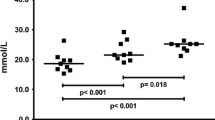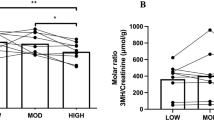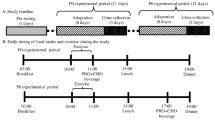Summary
The purpose of this study was to determine whether high intensity weight lifting exercise produces elevations of urinary 3-methylhistidine (3-MH), serum creatine kinase activity (CK), and serum myoglobin concentration (MY), and whether trained weight lifters differed in such responses when compared to a group of untrained subjects. Ten experienced male weight lifters (EWL) and seven untrained male subjects (IWL) performed three sets of six weight lifting exercises at 70%–80% of 1 RM. All subjects consumed a meat-free diet. The 3-MH:creatinine (3-MH:CR) values decreased 24 h and 48 h following exercise (P<0.05). The 12-h and 24-h postexercise CK response and the 12-h postexercise MY response increased for both EWL and IWL (P<0.05). However, EWL had a lower 24-h postexercise CK response and lower 12-h and 24-h postexercise MY responses compared to IWL (P<0.05). Within 48 h following weight lifting exercise, skeletal muscle protein degradation (as assessed by 3-MH:CR values) decreased regardless of prior training experience whereas skeletal muscle tissue damage (as assessed by CK and MY responses) increased. However, prior weight lifting training appeared to diminish the extent of muscle tissue damage.
Similar content being viewed by others
References
Abbott LB, Lott JA (1984) Creatine kinase. In: Kaplan L, Pesce A (eds) Clinical chemistry: Theory, analysis and correlation. The Mosby Company, St. Louis, pp 1112–1116
Ballard FJ, Tomas FM (1983) 3-methylhistidine as a measure of skeletal muscle protein breakdown in human subjects: The case for its continued use. Clin Sci 65:209–215
Clarkson PM, Tremblay I (1988) Exercise-induced muscle damage, repair, and adaptation in humans. J Appl Physiol 65:1–6
Dohm GL, Williams RT, Kasperek GJ, van Rij AM (1982) Increased excretion of urea and Nτ-methylhistidine by rats and humans after a bout of exercise. J Appl Physiol 52:27–33
Harper HA, Rodwell VW, Mayes PA (1977) Review of physiological chemistry 16th ed. Lange Medical Publications, Los Altos, CA
Harris CI (1981) Reappraisal of the quantitative importance of non-skeletal-muscle source of 3-methylhistidine in urine. Biochem J 194:1011–1014
Hickson JF, Wolinsky I, Rodriguez GP, Pivarnik JM, Kent MC, Shier NW (1986) Failure of weight training to affect urinary indices of protein metabolism in men. Med Sci Sports Exerc 18:563–567
Huszar G, Golenwsky G, Maiocco J, Davis E (1983) Urinary 3-methylhistidine excretion in man: The role of protein-bound and soluble 3-methylhistidine. Br J Nutr 49:287–294
Long CL, Dillard DR, Bodzin JH, Geiger JW, Blakemore WS (1988) Validity of 3-methylhistidine excretion as an indicator of skeletal muscle protein breakdown in humans. Metabolism 37:844–849
Maxwell JH, Bloor CM (1981) Effects of conditioning on exertional rhabdomyolysis and serum creatine kinase after severe exercise. Enzyme 26:177–181
Mendez J, Vollrath W, Druckemiller M (1983) Body composition among college wrestlers and sedentary students with emphasis on 3-methylhistidine excretion and calculation of muscle mass. In: Knuttgen G, Vogel JA, Poortmans J (eds) Biochemistry of Exercise 5th ed. Human Kinetics Publisher, Champaign, IL, pp 373–377
Millward DJ, Bates PC, Grimble GK, Brown JG, Nathan M, Rennie MJ (1980) Quantitative importance of non-skeletal-muscle sources of 3-methylhistidine in urine. Biochem J 190:225–228
Noakes TD (1987) Effect of exercise on serum enzyme activities in humans. Sports Med 4:245–267
Refsum HE, Stromme SB (1974) Urea and creatinine production and excretion in urine during and after prolonged heavy exercise. Scand J Clin Lab Invest 33:247–254
Ritter WS, Stone MH, Willerson JT (1979) Reduction in exertional myoglobinemia after physical conditioning. Arch Int Med 139:644–647
Roxin LE, Venge P, Friman G (1984) Variations in serum myoglobin after a 2-min isokinetic exercise test and the effects of training. Eur J Appl Physiol 53:43–47
Schroeder L (1982) Renal Disease: Nephrolithiasis. In: Anderson L, Dibble M, Turkki P, Mitchell H, Rynbergen H (eds) Nutrition in health and disease. J. B. Lippincott Co., Philadelphia, PA, pp 537–562
Tiidus PM, Ianuzzo CD (1983) Effects of intensity and duration of muscular exercise on delayed muscle soreness and serum enzymes. Med Sci Sports Exerc 15:461–465
Wassner SJ, Schlitzer JL, Li JB (1980) A rapid sensitive method for the determination of 3-methylhistidine levels in urine and plasma using high-pressure liquid chromatography. Anal Biochem 104:284–289
Author information
Authors and Affiliations
Additional information
This study was supported in part by Ross Laboratories, Columbus, Ohio and Rax Restaurants, Inc., Columbus, Ohio, USA
Rights and permissions
About this article
Cite this article
Paul, G.L., DeLany, J.P., Snook, J.T. et al. Serum and urinary markers of skeletal muscle tissue damage after weight lifting exercise. Europ. J. Appl. Physiol. 58, 786–790 (1989). https://doi.org/10.1007/BF00637392
Accepted:
Issue Date:
DOI: https://doi.org/10.1007/BF00637392




